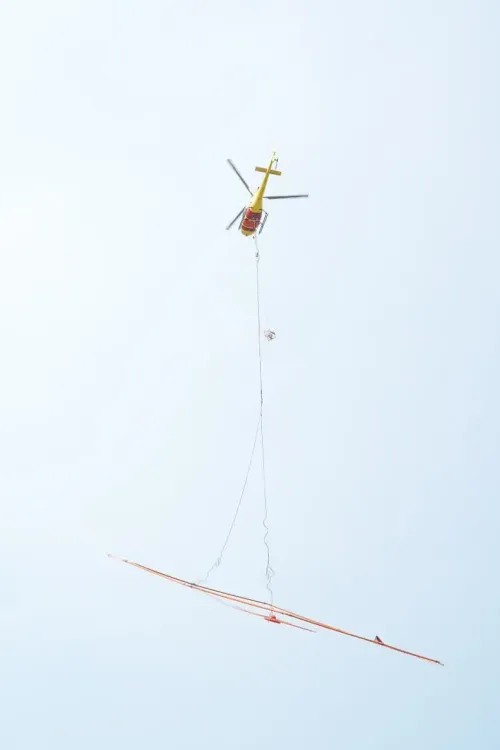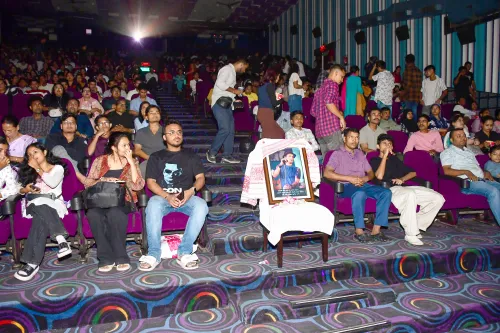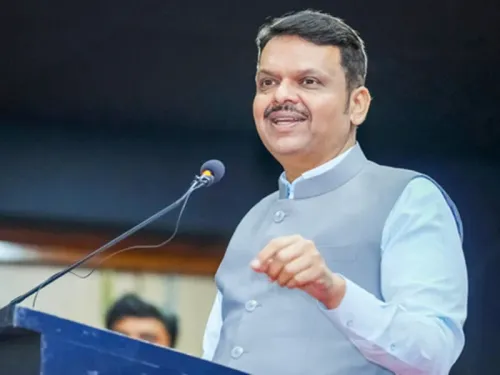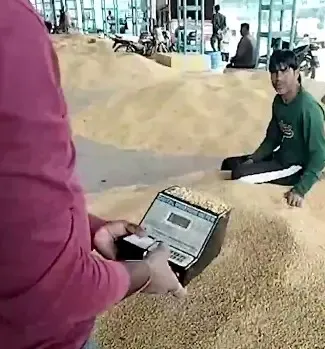What is the Significance of the Aerial Electromagnetic Survey for the SLBC Tunnel in Telangana?

Synopsis
Key Takeaways
- The aerial electromagnetic survey is crucial for the SLBC tunnel project.
- Conducted by NGRI, it will assess geological conditions and underground water flows.
- The SLBC project aims to irrigate 3 lakh acres and supply drinking water to 30 lakh people.
- The project has faced delays but is now being prioritized by the current government.
- Environmental precautions are being strictly observed due to the proximity to a Tiger Reserve.
Hyderabad, Nov 3 (NationPress) The aerial electromagnetic survey for the SLBC tunnel initiative was inaugurated in Telangana's Nagarkurnool district on Monday, with Chief Minister A. Revanth Reddy and Irrigation Minister Uttam Kumar Reddy in attendance.
This heliborne survey aims to support the ongoing activities related to the Srisailam Left Bank Canal (SLBC) project tunnel.
The sophisticated survey is under the guidance of experts from the National Geophysical Research Institute (NGRI).
Chief Minister Reddy, along with Uttam Kumar Reddy and Roads and Buildings Minister Komatireddy Venkat Reddy, visited Mannevaripalli village to evaluate the advanced transmitter system installed on a helicopter at the outlet point of the SLBC Tunnel-1.
NGRI scientists briefed the Chief Minister about the application of cutting-edge technology to analyze subsurface geological conditions. The survey is set to identify shear zones (rock formations) and assess underground water flows and their intensity at depths of 800 to 1000 meters, which are essential for advancing the SLBC tunnel operations.
After a comprehensive briefing, the Chief Minister authorized the helicopter to take off, marking the start of the aerial survey.
He and the ministers also boarded a second helicopter to witness the low-level aerial activities firsthand.
NGRI Director Dr. Prakash Kumar, scientist Dr. H. V. S. Satyanarayana, Irrigation Department Advisor Lt. Gen. Harpal Singh, and Army Officer Parikshit shared insights about the survey area, its technology, and methodology with the Chief Minister.
In his statements, the Chief Minister affirmed the government’s commitment to completing the long-awaited 40-km-long tunnel project by addressing all challenges.
“This project, which has been pending for over two decades, was revitalized after our administration took office. For the remaining 9.8 km of tunnel work, we have enlisted NGRI scientists and seasoned Army officers who specialize in tunnel construction,” he said.
Revanth Reddy emphasized that the survey led by NGRI will provide critical information on geological conditions, rock formations, and underground water flows up to 800 to 1000 meters deep, with measurements every 2.5 meters. “As the entire project area is within a Tiger Reserve, strict environmental measures are being followed,” he noted.
Started in 1983, the SLBC initiative aims to irrigate 3 lakh acres and supply drinking water to 30 lakh people through the natural flow of 30 TMCs of water from the Krishna River. However, work was stalled for two decades and was resumed in 2004 under the leadership of the late Chief Minister Dr. Y. S. Rajasekhara Reddy, when tunneling for the first two sections began.
Out of the total 44 km tunnel, nearly 33 km have been completed earlier, but the project faced total neglect over the last decade. “At its inception, this was among the most advanced tunnel projects globally, utilizing state-of-the-art tunnel boring technology,” remarked the CM.
This 44 km gravity-based tunnel is distinctive in India and is rarely seen elsewhere globally. Upon its completion, Telangana will receive significant acclaim, and the project will provide a water supply without additional power expenses. Currently, we incur Rs 500 crore annually solely on electricity for the AMR project, totaling Rs 5,000 crore over the past decade,” he said.
The Chief Minister announced that the government will compensate and address the concerns of residents from the submerged Marlapadu, Keshya Tanda, and Nakkalagandi areas near the SLBC project.
He criticized the former BRS administration for failing to finish the prestigious SLBC tunnel project during its decade-long tenure for political motives.
He accused former Chief Minister KCR and previous irrigation minister Harish Rao of intentionally delaying the project and creating obstacles to the water supply to Nalgonda through gravity.
CM Revanth Reddy stated that the project would have been completed at a cost of Rs 2,000 crore had the KCR government proceeded with it, but now the expenses have ballooned to Rs 4,500 crore.
The CM criticized KCR for not initiating any project on the Krishna River and spending Rs 1.86 lakh crore on contractors over ten years, including Rs 1.05 lakh crore on the Kaleshwaram project alone.
He assured that Uttam Kumar Reddy is making every effort to finalize the SLBC works by collaborating with Army officials to ensure future tunneling operations proceed smoothly.
Revanth Reddy expressed sorrow over the loss of eight workers during tunnel excavation in February, stating, “It was a tragic event, and we provided support to the affected families. This is why we have now engaged highly skilled and experienced professionals, including an Army officer, to oversee the project.”









